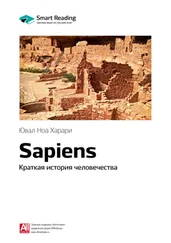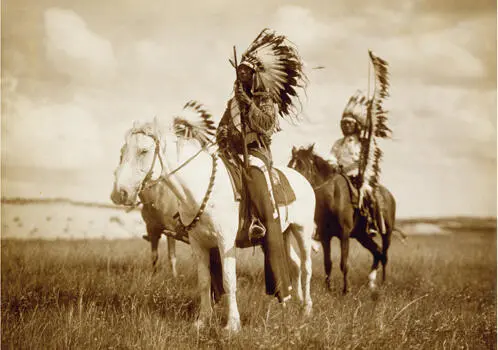
25. Sioux chiefs (1905). Neither the Sioux nor any other Great Plains tribe had horses prior to 1492.
Homo sapiens evolved to think of people as divided into us and them. ‘Us’ was the group immediately around you, whoever you were, and ‘them’ was everyone else. In fact, no social animal is ever guided by the interests of the entire species to which it belongs. No chimpanzee cares about the interests of the chimpanzee species, no snail will lift a tentacle for the global snail community, no lion alpha male makes a bid for becoming the king of all lions, and at the entrance of no beehive can one find the slogan: ‘Worker bees of the world – unite!’
But beginning with the Cognitive Revolution, Homo sapiens became more and more exceptional in this respect. People began to cooperate on a regular basis with complete strangers, whom they imagined as ‘brothers’ or ‘friends’. Yet this brotherhood was not universal. Somewhere in the next valley, or beyond the mountain range, one could still sense ‘them’. When the first pharaoh, Menes, united Egypt around 3000 BC, it was clear to the Egyptians that Egypt had a border, and beyond the border lurked ‘barbarians’. The barbarians were alien, threatening, and interesting only to the extent that they had land or natural resources that the Egyptians wanted. All the imagined orders people created tended to ignore a substantial part of humankind.
The first millennium BC witnessed the appearance of three potentially universal orders, whose devotees could for the first time imagine the entire world and the entire human race as a single unit governed by a single set of laws. Everyone was ‘us’, at least potentially. There was no longer ‘them’. The first universal order to appear was economic: the monetary order. The second universal order was political: the imperial order. The third universal order was religious: the order of universal religions such as Buddhism, Christianity and Islam.
Merchants, conquerors and prophets were the first people who managed to transcend the binary evolutionary division, ‘us vs them’, and to foresee the potential unity of humankind. For the merchants, the entire world was a single market and all humans were potential customers. They tried to establish an economic order that would apply to all, everywhere. For the conquerors, the entire world was a single empire and all humans were potential subjects, and for the prophets, the entire world held a single truth and all humans were potential believers. They too tried to establish an order that would be applicable for everyone everywhere.
During the last three millennia, people made more and more ambitious attempts to realise that global vision. The next three chapters discuss how money, empires and universal religions spread, and how they laid the foundation of the united world of today. We begin with the story of the greatest conqueror in history, a conqueror possessed of extreme tolerance and adaptability, thereby turning people into ardent disciples. This conqueror is money. People who do not believe in the same god or obey the same king are more than willing to use the same money. Osama Bin Laden, for all his hatred of American culture, American religion and American politics, was very fond of American dollars. How did money succeed where gods and kings failed?
IN 1519 HERNÁN CORTÉS AND HIS CONQUISTADORS invaded Mexico, hitherto an isolated human world. The Aztecs, as the people who lived there called themselves, quickly noticed that the aliens showed an extraordinary interest in a certain yellow metal. In fact, they never seemed to stop talking about it. The natives were not unfamiliar with gold – it was pretty and easy to work, so they used it to make jewellery and statues, and they occasionally used gold dust as a medium of exchange. But when an Aztec wanted to buy something, he generally paid in cocoa beans or bolts of cloth. The Spanish obsession with gold thus seemed inexplicable. What was so important about a metal that could not be eaten, drunk or woven, and was too soft to use for tools or weapons? When the natives questioned Cortés as to why the Spaniards had such a passion for gold, the conquistador answered, ‘Because I and my companions suffer from a disease of the heart which can be cured only with gold.’ 1
In the Afro-Asian world from which the Spaniards came, the obsession for gold was indeed an epidemic. Even the bitterest of enemies lusted after the same useless yellow metal. Three centuries before the conquest of Mexico, the ancestors of Cortés and his army waged a bloody war of religion against the Muslim kingdoms in Iberia and North Africa. The followers of Christ and the followers of Allah killed each other by the thousands, devastated fields and orchards, and turned prosperous cities into smouldering ruins – all for the greater glory of Christ or Allah.
As the Christians gradually gained the upper hand, they marked their victories not only by destroying mosques and building churches,but also by issuing new gold and silver coins bearing the sign of the cross and thanking God for His help in combating the infidels. Yet alongside the new currency, the victors minted another type of coin, called the millares, which carried a somewhat different message. These square coins made by the Christian conquerors were emblazoned with flowing Arabic script that declared: ‘There is no god except Allah, and Muhammad is Allah’s messenger.’ Even the Catholic bishops of Melgueil and Agde issued these faithful copies of popular Muslim coins, and God-fearing Christians happily used them. 2
Tolerance flourished on the other side of the hill too. Muslim merchants in North Africa conducted business using Christian coins such as the Florentine florin, the Venetian ducat and the Neapolitan gigliato. Even Muslim rulers who called for jihad against the infidel Christians were glad to receive taxes in coins that invoked Christ and His Virgin Mother. 3
How Much is It?
Hunter-gatherers had no money. Each band hunted, gathered and manufactured almost everything it required, from meat to medicine, from sandals to sorcery. Different band members may have specialised in different tasks, but they shared their goods and services through an economy of favours and obligations. A piece of meat given for free would carry with it the assumption of reciprocity – say, free medical assistance. The band was economically independent; only a few rare items that could not be found locally – seashells, pigments, obsidian and the like – had to be obtained from strangers. This could usually be done by simple barter: ‘We’ll give you pretty seashells, and you’ll give us high-quality flint.’
Little of this changed with the onset of the Agricultural Revolution. Most people continued to live in small, intimate communities. Much like a hunter-gatherer band, each village was a self-sufficient economic unit, maintained by mutual favours and obligations plus a little barter with outsiders. One villager may have been particularly adept at making shoes, another at dispensing medical care, so villagers knew where to turn when barefoot or sick. But villages were small and their economies limited, so there could be no full-time shoemakers and doctors.
The rise of cities and kingdoms and the improvement in transport infrastructure brought about new opportunities for specialisation. Densely populated cities provided full-time employment not just for professional shoemakers and doctors, but also for carpenters, priests, soldiers and lawyers. Villages that gained a reputation for producing really good wine, olive oil or ceramics discovered that it was worth their while to specialise nearly exclusively in that product and trade it with other settlements for all the other goods they needed. This made a lot of sense. Climates and soils differ, so why drink mediocre wine from your backyard if you can buy a smoother variety from a place whose soil and climate is much better suited to grape vines? If the clay in your backyard makes stronger and prettier pots, then you can make an exchange. Furthermore, full-time specialist vintners and potters, not to mention doctors and lawyers, can hone their expertise to the benefit of all. But specialisation created a problem – how do you manage the exchange of goods between the specialists?
Читать дальше
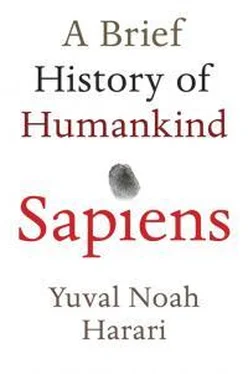



![Юваль Ной Харари - Sapiens. Краткая история человечества [litres]](/books/34310/yuval-noj-harari-sapiens-kratkaya-istoriya-cheloveche-thumb.webp)
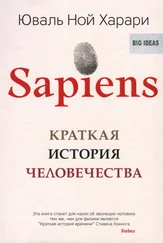


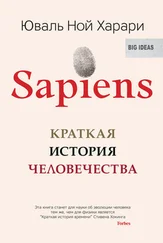

![Юваль Ной Харари - 21 урок для XXI века [Версия с комментированными отличиями перевода]](/books/412481/yuval-noj-harari-21-urok-dlya-xxi-veka-versiya-s-ko-thumb.webp)


